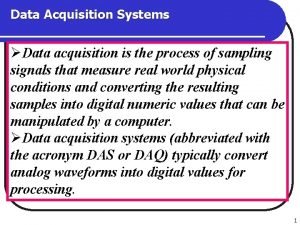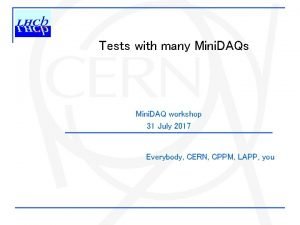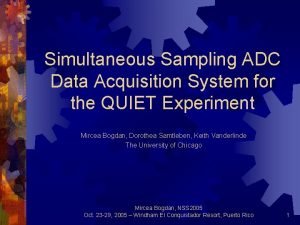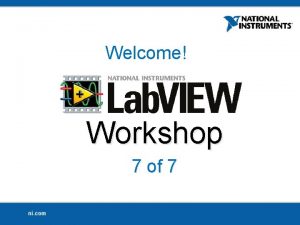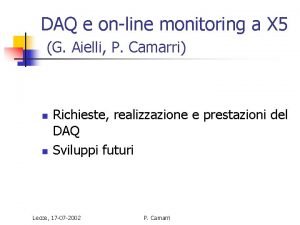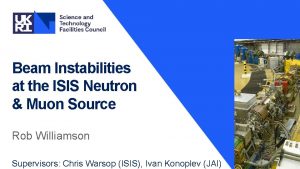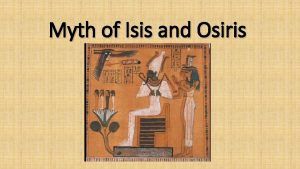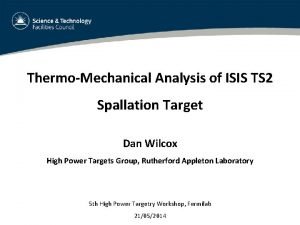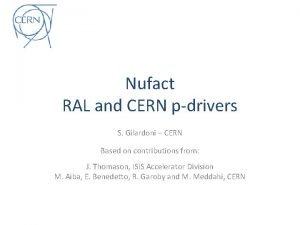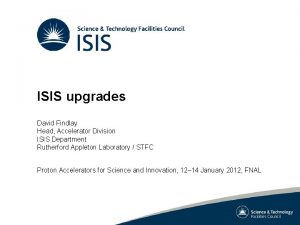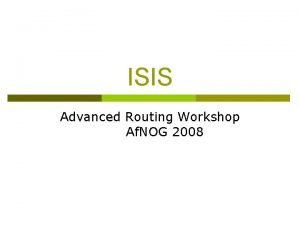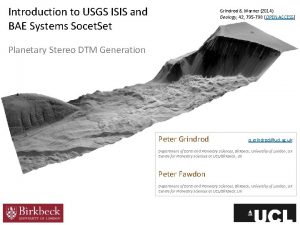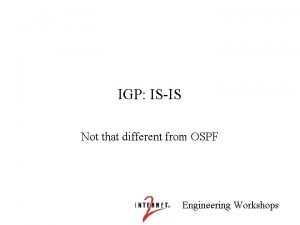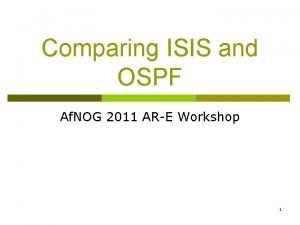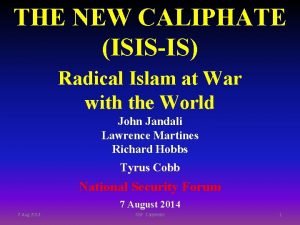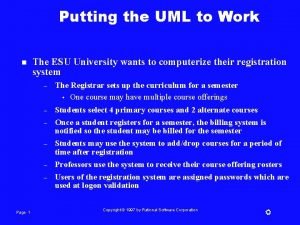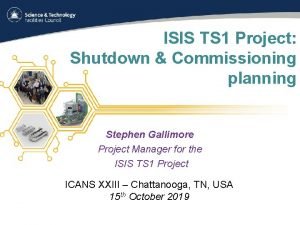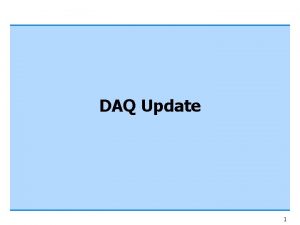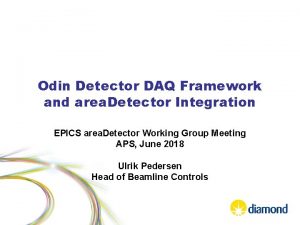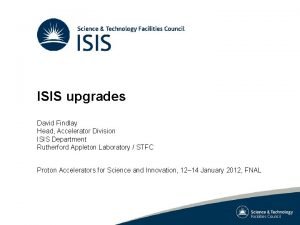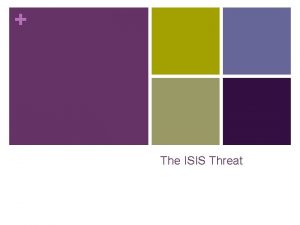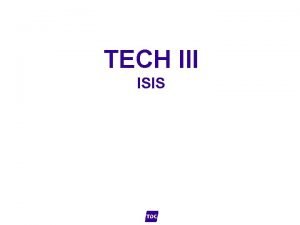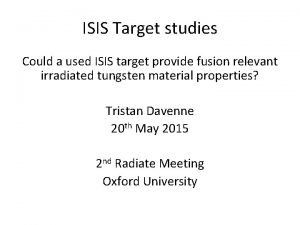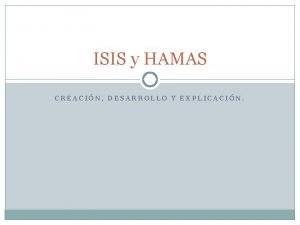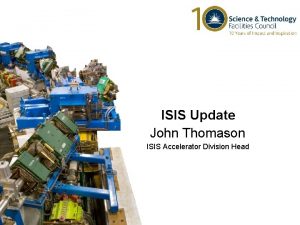MICE DAQ MICE and ISIS Introduction MICE Detector





















- Slides: 21

MICE DAQ … • MICE and ISIS Introduction • MICE Detector Front End Electronics • Software and MICE DAQ Architecture • MICE Triggers • Status and Schedule January 31, 2007 Terry Hart, Illinois Institute of Technology, NFMC Collaboration Meeting, UCLA 1

Introduction – MICE Description • Muon Ionization Cooling Experiment (MICE): international accelerator R&D project designed to provide first demonstration of muon cooling. • MICE is being built at Rutherford Appleton Laboratory (RAL) using muon beam generated from ISIS. • One muon cooling lattice cell with detectors measuring muon beam emittance before and after cooling. January 31, 2007 Terry Hart, Illinois Institute of Technology, NFMC Collaboration Meeting, UCLA 2

Introduction – ISIS Beam Structure 100 ns ●●● 324 ns ~ 1 ms = 1, 000 ns ISIS proton spills: - 20 ms apart (50 Hz) - About 1 ms wide - Contain ~ 3000 proton bursts - Proton bursts are ~100 ns wide and 324 ns apart MICE RF cavity duty cycle limits the spill rate for MICE to 1 Hz. January 31, 2007 Terry Hart, Illinois Institute of Technology, NFMC Collaboration Meeting, UCLA 3

Systems for MICE DAQ • Target System: Titanium target inserted into ISIS proton beam produces pions which decay into muons. • RF Cavities: Eight 201 MHz cavities which accelerate muons along length of MICE. • DAQ: Data from MICE trackers, calorimeter, Cherenkov detectors, and time -of-flight counters will be combined to form MICE events. These systems need to be synchronized for MICE data collection. ISIS proton spill → MICE target → pions, muons → MICE RF Cavities and Detectors … January 31, 2007 Terry Hart, Illinois Institute of Technology, NFMC Collaboration Meeting, UCLA 4

Introduction – MICE Detectors Time-of-flight Counters Cherenkov detector Trackers • MICE DAQ acquires data from – – • Calorimeter Trackers Calorimeter Cherenkov detector Time-of-flight counters With 600 k. Hz muon rate within 1 ms wide spill, detector data will be buffered, read out, and built into an event at end of each spill. January 31, 2007 Terry Hart, Illinois Institute of Technology, NFMC Collaboration Meeting, UCLA 5

Front End Electronics (FEE) for Tracker • Sixteen 512 -channel Analog Front End II t (AFE-IIt) boards will read out data from two trackers. – Tracker data are • Bitmap of tracker channels with analog charge above preset thresholds • Digitization of amount of charge of each channel • Digitization of time of hit with respect to fixed time – AFE-IIt boards developed for latest D 0 experiment upgrade. • Tracker firmware is being modified to be suitable for 600 k. Hz muon rate – Reduce digitization time – Make use of 4 -level buffer so that digitization time isn’t dead time • Expected tracker data rate ~3 Mbytes/spill. January 31, 2007 Terry Hart, Illinois Institute of Technology, NFMC Collaboration Meeting, UCLA 6

Tracker FEE Firmware Reducing Digitization Time – Assumed muon rate is 600 k. Hz for average time between muons of 1667 ns. – Clock period taken as 18 ns – Assume 2 out of 32 channels of Tri. P-t have charge data above threshold • • • ~ 5724 ns: D 0 implementation ~ 5670 ns: Adjust for shorter ISIS bucket period 4536 ns: Tri. P-t pipeline collect data during digitization 2376 ns: Zero-suppress 30 of 32 Tri. P-t channels 1836 ns: Reduce zero-suppression time from 2 to 1 cycle. 1566 ns: Remove cycles from set-up processes. We are now starting to reduce the dead time so that it’s comparable to the average time between muons. January 31, 2007 Terry Hart, Illinois Institute of Technology, NFMC Collaboration Meeting, UCLA 7

Tracker FEE Firmware Reducing Digitization Time and Using Buffer – Clock period taken as 18 ns – Assume 2 out of 32 channels of Tri. P-t have charge data above threshold Fraction of Recorded Muons for 600 k. Hz No Buffering tdigi = 5670 ns tdigi = 2376 ns tdigi = 1836 ns tdigi = 1566 ns January 31, 2007 0. 227 0. 412 0. 476 0. 516 1 -level Buffer 0. 291 0. 601 0. 699 0. 753 Terry Hart, Illinois Institute of Technology, NFMC Collaboration Meeting, UCLA 8

Time-of-Flight Counters FEE • Will use CAEN V 1290 TDC with 25 ps LSB (least significant bit) with constant fraction discriminators • Considering time-over-threshold discriminator with leading edge and trailing edge measurement allowing more precise time walk correction • 60 ps resolution on time of flight measurement has been obtained in test beam. January 31, 2007 Terry Hart, Illinois Institute of Technology, NFMC Collaboration Meeting, UCLA 9

Calorimeter and Cherenkov Detector FEE • Charge will be measured with 14 bit, 100 MHz flash ADCs (CAEN V 1724) coupled with RC shapers. • Pulse shape analysis (after shaper) allows time resolution ~500 ps => no additional TDC needed. • Cosmic ray and beam data taken and analyses underway. January 31, 2007 Terry Hart, Illinois Institute of Technology, NFMC Collaboration Meeting, UCLA 10

MICE DAQ Hardware and Software • MICE DAQ software will be built from DATE framework used by CERN experiment ALICE – ALICE = A Large Ion Collider Experiment – DATE = Data Acquisition and Test Environment • MICE detectors read out over VME. • Online data stream will include list of selected physical variables from MICE Control and Monitoring (MCM). • Data runs will be stopped automatically when a subsystem goes into fault status or in case of connection problem. January 31, 2007 Terry Hart, Illinois Institute of Technology, NFMC Collaboration Meeting, UCLA 11

MICE DAQ Architecture Trigger distribution VME Crates Calorimeter Tracker Optical links Time of Flight Counters Trigger+ Cherenkov Linux PCs 100 Mega. Bit Switch Giga. Bit Switch Remote Mass Storage MICE Control and Monitoring Readout January 31, 2007 Run Control Online Storage Monitoring Data Flow Event Builder MCM Subnet Terry Hart, Illinois Institute of Technology, NFMC Collaboration Meeting, UCLA 12

Synchronization Issue • 3 subsystems have to be synchronized with each other and with the ISIS Machine Cycle: – Target – RF – DAQ • An “As Soon As Ready” approach has been proposed – Each system provides a veto signal which is set when the system is not ready to receive a trigger. – The first ISIS Machine Start (MS) after all vetos are dropped generates the different triggers. January 31, 2007 Terry Hart, Illinois Institute of Technology, NFMC Collaboration Meeting, UCLA 13

MICE Veto DAQ Veto Target Veto RF Veto Target Request RF Request MS 20 ms Extraction Target Delay Target Trigger Protons on target RF Delay RF Trigger RF Power DT Delay DT Gate DAQ Trigger January 31, 2007 Terry Hart, Illinois Institute of Technology, NFMC Collaboration Meeting, UCLA 14

Triggers • DAQ Trigger – Triggers the readout of the FEE output buffer memory – Arrives at the end of spill – Distributed to all VME crates • Particle Trigger – Triggers the digitization of the signals arriving at the FEE (Trackers, Calorimeter, Cherenkov detector, Time-of-Flight counters) – Distributed to all FEE boards – MICE expects about 600 Particle Triggers for 1 DAQ trigger January 31, 2007 Terry Hart, Illinois Institute of Technology, NFMC Collaboration Meeting, UCLA 15

DAQ Trigger • DATE requires dedicated inputs for at least four event types: Start of Spill Signal sent to DAQ slightly before the beginning of the spill ensuring that all detectors are ready to receive data. This is a preparation signal for Physics events. Physics Normal data from events occurring in a proton spill. Event is built from data from each detector. End of Spill Signal sent to DAQ when the readout is finished checking that detectors read out data correctly. Calibration The following are possible ways to calibrate detectors. - Empty event (pedestal) - Pulser event - Cosmic ray event January 31, 2007 Terry Hart, Illinois Institute of Technology, NFMC Collaboration Meeting, UCLA 16

Particle Trigger Conditions for Normal Events – Burst: ISIS burst with • Target within the Data Taking (DT)-Gate • FEE not busy – Beam: Burst TOF 0 – Upstream: Beam TOF 1 – Traversing: Upstream TOF 2 TOF 0 TOF 1 January 31, 2007 TOF 2 Terry Hart, Illinois Institute of Technology, NFMC Collaboration Meeting, UCLA 17

Particle Trigger • Simplest Implementation of the Trigger Condition selection using output Register OReg 1 Burst TOF 0 TOF 1 TOF 2 OReg 3 Particle Trigger Request FEE Busy Particle Trigger OReg 4 • Setting OReg selects the trigger condition January 31, 2007 Terry Hart, Illinois Institute of Technology, NFMC Collaboration Meeting, UCLA 18

MICE Status and Schedule m STEP II September 2007 NB: picture does not include target, beam line, hall infrastructure, electronics, DAQ, shifters etc… ! November 2007 STEP III: Winter 2008 STEP IV Fall 2008 STEP V Spring 2009 STEP VI Fall 2009 January 31, 2007 Terry Hart, Illinois Institute of Technology, NFMC Collaboration Meeting, UCLA 19

MICE DAQ Summary • DAQ architecture determined – DATE framework – Detector FEEs readout by VME – Control and monitoring established • Detector FEEs under development – Tracker FEE software being modified from D 0 – FEE hardware for calorimeter, time-of-flight counters, and Cherenkov detectors under consideration • Trigger signals and run modes established January 31, 2007 Terry Hart, Illinois Institute of Technology, NFMC Collaboration Meeting, UCLA 20

MICE DAQ Status and Schedule • February, 2007: DAQ test bench set up at University of Geneva • March, 2007: Order MICE Stage 1 FEE hardware • July, 2007: Move MICE DAQ system to RAL • September, 2007: DAQ working in MICE Stage 1 January 31, 2007 Terry Hart, Illinois Institute of Technology, NFMC Collaboration Meeting, UCLA 21
 Data acquisition system block diagram
Data acquisition system block diagram Mini daq
Mini daq Daq scrabble
Daq scrabble Simultaneous sampling daq
Simultaneous sampling daq Clark county daq
Clark county daq Daq assistant express vi download
Daq assistant express vi download Daq online
Daq online Isis neutron and muon source
Isis neutron and muon source Isis and ra
Isis and ra Isis
Isis Isis level 1 vs level 2
Isis level 1 vs level 2 Ral tabel
Ral tabel Isis
Isis Isis level 1 vs level 2
Isis level 1 vs level 2 Usgs isis
Usgs isis Isis igp
Isis igp Idaaas
Idaaas Ospf vs isis
Ospf vs isis Isis plans
Isis plans How many objects are there
How many objects are there Isis europa
Isis europa Isis tranny
Isis tranny
